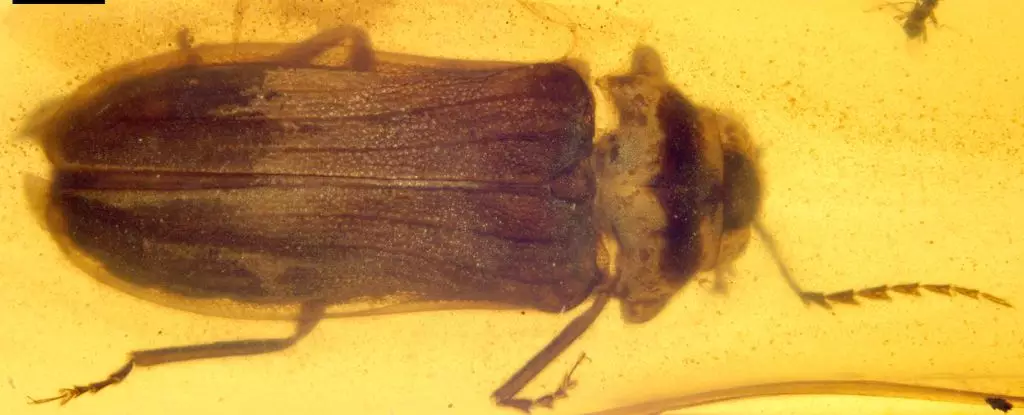As the sun dips below the horizon during summer evenings, the air fills with a palpable sense of magic as fireflies emerge from their hiding places. Their bioluminescent glow punctuates the dusk with flickers of light, transforming ordinary backyards into enchanting realms. These fascinating beetles, representing about 2,500 species worldwide, possess the extraordinary ability to produce light. Yet, beneath this ethereal beauty lies a complex evolutionary history that scientists are only beginning to unravel.
Recent research led by Chenyang Cai from the Chinese Academy of Sciences has shed light on this mystery, providing insights that date back approximately 99 million years. A fossilized firefly—Flammarionella hehaikuni—has been preserved in amber, offering a rare window into Mesozoic life. This discovery not only highlights the presence of bioluminescence in ancient ecosystems but also raises critical questions regarding its evolutionary pathways.
The amber found in Kachin State, Myanmar, proves to be a treasure trove for paleontologists. Included among its many ancient residents are specimens that reveal the diverse adaptations of fireflies and related insects. Flammarionella hehaikuni stands out with its distinct lantern structure, which differs from that of its contemporaries like Protoluciola albertalleni, another Mesozoic firefly discovered in the same region. The diversity of lantern designs suggests that by the Late Cretaceous period, bioluminescence in these insects was not merely an emerging trait but had already evolved into varied forms serving multiple ecological functions.
The fossil’s preservation offers remarkable detail, depicting the insect’s physical attributes, including its unique antennae adorned with setae—tiny hair-like structures that enhance its olfactory capabilities. This characteristic indicates a possible significance in recognizing pheromones, critical for mating rituals and social interactions, hinting at the complex social dynamics present in these ancient creatures.
Biologists have long debated the evolutionary utility behind the striking bioluminescent features of fireflies. Traditionally seen as mechanisms for sexual attraction, these glowing appendages serve a dual purpose, acting as both lures for mates and a deterrent for predators. The lucibufagins—toxins associated with certain firefly species—that dissuade would-be attackers form a fascinating layer to this narrative. However, the emerging hypothesis posits that bioluminescence existed independently of these toxic defenses, pushing researchers to reconsider the early evolutionary benefits of light production.
Yet, the intricacies of this evolutionary feature may not be fully understood until further research examines male counterparts of Flammarionella. The male fireflies, often sporting fancier antennae, are essential for a comprehensive understandings of these evolutionary adaptations, potentially revealing underlying biological imperatives that guided the development of bioluminescence.
Through the unearthing of fossilized specimens, the scientific community is ignited with curiosity regarding lesser-known firefly relatives and their evolutionary trajectories. Each new discovery holds the potential to alter our understanding of not only fireflies but also the ecosystems in which they thrived millions of years ago.
The implications of discovering Mesozoic fireflies extend beyond mere curiosity. Understanding their adaptations can offer insights into modern-day biodiversity and inform conservation efforts for current firefly populations, many of which face environmental pressures. As research continues, it will delve into the intricacies surrounding the evolutionary history of bioluminescence and the fascinating interplay between insects and their habitats.
Fireflies offer more than just aesthetic wonders; they embody evolutionary tales spanning millions of years. With ongoing studies and discoveries, we are inching closer to uncovering the mysteries surrounding these radiant insects, piecing together a vibrant picture of life during the age of dinosaurs—a flickering reminder of nature’s ingenuity.


Leave a Reply